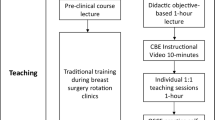ABSTRACT
The clinical breast exam (CBE) is an important tool in the care of women. However, the utility of the screening CBE has been called into question. This article discusses the importance of the CBE as a physical diagnosis tool. Recommendations regarding screening with CBE are reviewed, and evidence surrounding breast cancer screening using CBE is briefly summarized. Clinicians should strive to provide high quality CBEs as part of the general clinical exam for women, particularly those who present with breast complaints, and for patients who choose to have CBE screening. In conclusion, there is a role for the CBE in the care of women, and clinicians should be proficient at performing these exams. Simulation teaching technologies are now available at Department of Veteran Affairs (VA) facilities to enable clinicians to improve their CBE skills.



Similar content being viewed by others
REFERENCES
Preventive US. Services Task Force. Screening for breast cancer: U.S. Preventive Services Task Force recommendation statement. Ann Intern Med. 2009;151(10):716–726.
Barton MB, Elmore JG, Fletcher SW. Breast symptoms among women enrolled in a health maintenance organization: frequency, evaluation, and outcome. Ann Intern Med. 1999;130(8):651–657.
Haakinson DJ, Stucky CH, Dueck AC, et al. A significant number of women present with palpable breast cancer even with a normal mammogram within 1 year. Am J Surg. 2010;200(6):712–717. discussion 717–8.
Barlow WE, Lehman CD, Zheng Y, et al. Performance of diagnostic mammography for women with signs or symptoms of breast cancer. J Natl Cancer Inst. 2002;94(15):1151–1159.
Smith RA, Cokkinides V, Brawley OW. Cancer screening in the United States, 2012: a review of current American cancer society guidelines and issues in cancer screening. CA Cancer J Clin. 2012;62(2):129–142.
The American College of Obstetricians-Gynecologists. Practice bulletin no. 122: breast cancer screening. Obstet Gynecol. 2011;118:372–382.
Barton MB, Harris R, Fletcher SW. Does this patient have breast cancer? The screening clinical breast examination: should it be done? JAMA. 1999;282(13):1270–1280.
Bobo JK, Lee NC, Thames SF. Findings from 752,081 clinical breast examinations reported to a national screening program from 1995 through 1998. J Natl Cancer Inst. 2000;92(12):971–976.
Miller AB, To T, Baines CJ, Wall C. Canadian National Breast Screening Study-2: 13-year results of a randomized trial in women aged 50–59 years. J Natl Cancer Inst. 2000;92(18):1490–1499.
Ma I, Dueck A, Gray R, et al. Clinical and self breast examination remain important in the era of modern screening. Ann Surg Oncol. 2012;5:1484–1490.
Weiss NS. Breast cancer mortality in relation to clinical breast examination and breast self-examination. Breast J. 2003;9(Suppl 2):S86–S89.
Checka CM, Chun JE, Schnabel FR, Lee J, Toth H. The Relationship of Mammographic Density and Age: Implications for Breast Cancer Screening. AJR Am J Roentgenol. 2012; 198(3):W292–5.
Corbex M, Burton R, Sancho-Garnier H. Breast cancer early detection methods for low and middle income countries, a review of the evidence. Breast. 2012;21:428–434.
Okonkwo, Draisma G, Kinderen A, Brown ML, Koning H. Breast cancer screening policies in developing countries. J Natl Cancer Inst. 2008;100(18):1290–1300.
Sankaranarayanan R, Ramadas K, Thara S, et al. Clinical breast examination: preliminary results from a cluster randomized controlled trial in India. J Natl Cancer Inst. 2011;103(19):1476–1480.
Chiarelli AM, Majpruz V, Brown P, Thériault M, Shumak R, Mai V. The contribution of clinical breast examination to accuracy of breast screening. J Natl Cancer Inst. 2009;101(18):1236–1243.
Kalager M, Adami H, Bretthauer M, Tamimi RM. Overdiagnosis of invasive breast cancer due to mammogram screening: results from the Norwegian Screening Program. Ann Intern Med. 2012;156(7):491–499.
Elmore JG, Barton MB, Moceri VM, Polk S, Arena PJ, Fletcher SW. Ten-year risk of false positive screening mammograms and clinical breast examinations. N Eng J Med. 1998;338(16):1089–1096.
Davey HM, Barratt AL, Davey E, Butow PN, et al. Medical tests: women’s reported and preferred decision-making roles and preferences for information on benefits, side-effects and false results. Health Expect. 2002;5(4):330–340.
Dunn AS, Shridharani KV, Lou W, Bernstein J, Horowitz CR. Physician-patient discussions of controversial cancer screening tests. Am J Prev Med. 2001;20(2):130–134.
Kurtz ME, Given B, Given CW, Kurtz JC. Relationships of barriers and facilitators to breast self-examination, mammography, and clinical breast examination in a worksite population. Cancer Nurs. 1993;16(4):251–259.
Saslow D, Hannon J, Osuch J, et al. Clinical breast examination: practical recommendations for optimizing performance and reporting. CA Cancer J Clin. 2004;54(6):327–344.
Steiner E, Austin DF, Prouser NC. Detection and description of small breast masses by residents trained using a standardized clinical breast exam curriculum. J Gen Intern Med. 2008;23(2):129–134.
Pugh CM, Salud LH. Fear of missing a lesion: use of simulated breast models to decrease student anxiety when learning clinical breast examinations. Am J Surg. 2007;193:766–770.
Schubart JR, Erdahl L, Smith JS, Purichia H, Kauffman GL, Kass RB. Use of breast simulators compared with standardized patients in teaching the clinical breast examination to students. J Surg Educ. 2012;69(3):416–422.
Kyoto Kagaku Co., LTD. http://www.kyotokagaku.com/products/detail01/m44.html. Accessed January 1, 2013.
Gaumard-Simulators for Healthcare Education. http://www.gaumard.com/breast-examination-simulator-s230-42/ Accessed January 1, 2013.
MammaCare- Clinical Breast Exam Certification and Breast Self-Exam Teaching. http://www.mammacare.com/index.php. Accessed January 1, 2013.
Conflict of Interest
The authors are not affiliated with any CBE simulation products. They have no acknowledgement or funding sources to disclose. The authors declare that they do not have a conflict of interest.
The views expressed in this article are those of the authors and do not necessarily reflect the position or policy of the Veterans Health Administration.
Author information
Authors and Affiliations
Corresponding author
Rights and permissions
About this article
Cite this article
Bryan, T., Snyder, E. The Clinical Breast Exam: A Skill that Should Not Be Abandoned. J GEN INTERN MED 28, 719–722 (2013). https://doi.org/10.1007/s11606-013-2373-9
Published:
Issue Date:
DOI: https://doi.org/10.1007/s11606-013-2373-9




